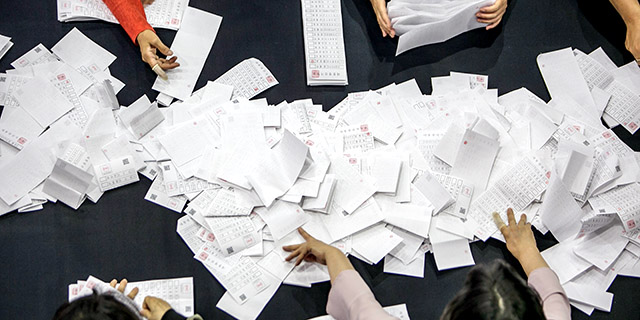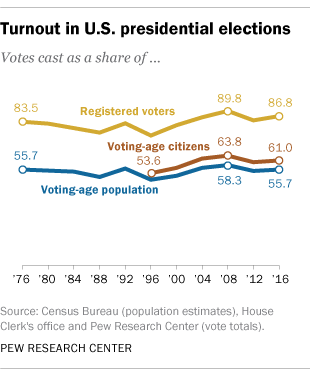What Percentage Of Registered Voters Vote

If early voting trends are any indication, a record number of Americans could vote in the 2020 presidential election. As of this writing, more than 100 million early votes have been cast past mail or in person – more than than 2-thirds of the total number of votes cast in 2016.
Nosotros won't accept annihilation like a definitive assessment of 2020 turnout rates for some time after Nov. iii. But in the 2016 presidential ballot, nearly 56% of the U.S. voting-age population cast a election. That represented a slight uptick from 2012 only was lower than in the record year of 2008, when turnout topped 58% of the voting-age population.
So how does voter turnout in the United States compare with turnout in other countries? That depends very much on which country you lot're looking at and which measuring stick y'all utilise.
Political scientists often ascertain turnout as votes cast divided by the number of eligible voters. Merely because eligible-voter estimates are not readily bachelor for many countries, we're basing our cross-national turnout comparisons on estimates of voting-historic period population (or VAP), which are more readily available, too as on registered voters. (Read "How we did this" for details.)
Comparing U.South. national election turnout rates with rates in other countries can yield different results, depending on how turnout is calculated. Political scientists often ascertain turnout as votes bandage divided by the estimated number of eligible voters. But eligible-voter estimates are hard or incommunicable to find for many nations. So to compare turnout calculations internationally, we're using two different denominators: total registered voters and estimated voting-historic period populations, or VAP, considering they're readily bachelor for nigh countries.
Nosotros calculated turnout rates for the most recent national election in each country, except in cases where that election was for a largely ceremonial position or for European Parliament members (turnout is often substantially lower in such elections). Voting-age population turnout is derived from estimates of each country'due south VAP by the International Establish for Democracy and Balloter Assistance. Registered-voter turnout is derived from each country'due south reported registration data. Because of methodological differences, in some countries Thought's VAP estimates are lower than the reported number of registered voters.
In addition to information from Thought, information is likewise drawn from the U.Due south. Census Bureau, the Office of the Clerk of the U.S. House of Representatives, and individual nations' statistical and election authorities.
Overall, 245.5 million Americans were ages 18 and older in November 2016, about 157.6 million of whom reported being registered to vote, according to Demography Agency estimates. Merely over 137.five million people told the census they voted that year, somewhat higher than the actual number of votes tallied – nearly 136.8 1000000, according to figures compiled past the Function of the Clerk of the U.S. House of Representatives (which include more than than 170,000 blank, spoiled or otherwise null ballots). That sort of overstatement has long been noted by researchers; the comparisons and charts in this analysis use the House Clerk's figure, along with information from the International Constitute for Republic and Electoral Assistance and individual nations' statistical and elections authorities.
The 55.seven% VAP turnout in 2016 puts the U.Due south. behind well-nigh of its peers in the Organization for Economical Cooperation and Development, most of whose members are highly developed democratic states. Looking at the most recent nationwide election in each OECD nation, the U.S. places 30th out of 35 nations for which data is bachelor.
The highest turnout rates among OECD nations were in Turkey (89% of voting-historic period population), Sweden (82.1%), Australia (fourscore.eight%), Kingdom of belgium (77.nine%) and South korea (77.9%). Switzerland consistently has the lowest turnout in the OECD: In 2019 federal elections, barely 36% of the Swiss voting-historic period population voted.
One cistron behind the consistently high turnout rates in Commonwealth of australia and Belgium may exist that they are amongst the 21 nations effectually the world, including half-dozen in the OECD, with some form of compulsory voting. 1 county in Switzerland has compulsory voting as well.
While compulsory-voting laws aren't ever strictly enforced, their presence or absenteeism can have dramatic effects on turnout. In Chile, for example, turnout plunged later the state moved from compulsory to voluntary voting in 2012 and began automatically putting all eligible citizens on the voter rolls. Fifty-fifty though essentially all voting-age citizens were registered to vote in Chile'due south 2013 elections, turnout in the presidential race plunged to 42%, versus 87% in 2010 when the compulsory-voting law was nevertheless in place. (Turnout rebounded slightly in the 2017 presidential election, to 49% of registered voters.)
Republic of chile's state of affairs points to yet another complicating factor when comparing turnout rates beyond countries: the distinction betwixt who's eligible to vote and who'south actually registered to practice then. In many countries, the national government takes the pb in getting people'southward names on the rolls – whether by registering them automatically once they get eligible (as in, for case, Sweden or Deutschland) or by aggressively seeking out and registering eligible voters (as in the UK and Australia). As a result, turnout looks pretty like regardless of whether you're looking at voting-age population or registered voters.
In the U.S., by contrast, registration is decentralized and mainly an individual responsibleness. And registered voters represent a much smaller share of potential voters in the U.Southward. than in many other countries. Only about 64% of the U.S. voting-age population (and 70% of voting-age citizens) was registered in 2016, according to the Census Bureau. The U.S. rate is much lower than many other OECD countries: For example, the share of the voting-age population that is registered to vote is 92% in the Uk (2019), 93% in Canada (2019), 94% in Sweden (2018) and 99% in Slovakia (2020). Luxembourg also has a low rate (54%), although it represents something of a special case because nigh half of the tiny country's population is foreign born.

As a upshot, turnout comparisons based but on registered voters may not be very meaningful. For case, U.Southward. turnout in 2016 was 86.8% of registered voters, 5th-highest amidst OECD countries and second-highest amongst those without compulsory voting. But registered voters in the U.Southward. are much more than of a self-selected grouping, already more than likely to vote because they took the trouble to register themselves.
There are even more ways to summate turnout. Michael McDonald, a political scientist at the Academy of Florida who runs the United States Election Project, estimates turnout equally a share of the "voting-eligible population" past subtracting noncitizens and ineligible felons from the voting-age population and calculation eligible overseas voters. Using those calculations, U.S. turnout improves somewhat, to 60.1% of the 2016 voting-eligible population. Withal, McDonald doesn't calculate comparable estimates for other countries.
No matter how they're measured, U.Due south. turnout rates have been fairly consistent over the by several decades, despite some election-to-election variation. Since 1976, voting-age turnout has remained inside an 8.5 percentage betoken range – from just nether 50% in 1996, when Bill Clinton was reelected, to merely over 58% in 2008, when Barack Obama won the White House. However, turnout varies considerably amid dissimilar racial, ethnic and age groups.
In several other OECD countries, turnout has drifted lower in recent decades. Greece has a compulsory-voting police force on the books, though information technology's not enforced; turnout there in parliamentary elections fell from 89% in 2000 to 63.5% last yr. In Kingdom of norway's almost recent parliamentary elections, 2017, 70.6% of the voting-age population cast ballots – the lowest turnout charge per unit in at least four decades. And in Slovenia, a burst of enthusiasm followed the country's independence from Yugoslavia in 1992, when 85% of the voting-age population cast ballots – but turnout has fallen nearly 31 percentage points in 2-and-a-half decades of commonwealth, sinking to 54.6% in 2018.
On the other manus, turnout in contempo elections has bumped upward in several OECD countries. Canadian turnout in the 2 most contempo parliamentary elections (2015 and 2019) topped 62%, the highest rate since 1993. In Slovakia'due south legislative elections this past Feb, well-nigh 2-thirds (65.4%) of the voting-age population bandage ballots, up from 59.iv% in 2016. And in Hungary's 2018 parliamentary elections, nearly 72% of the voting-historic period population voted, up from 63.3% in 2014.
Notation: This is an update of a postal service originally published May vi, 2015.
What Percentage Of Registered Voters Vote,
Source: https://www.pewresearch.org/fact-tank/2020/11/03/in-past-elections-u-s-trailed-most-developed-countries-in-voter-turnout/
Posted by: cramptonsmis1975.blogspot.com


0 Response to "What Percentage Of Registered Voters Vote"
Post a Comment